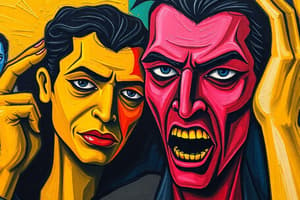Podcast
Questions and Answers
What is the definition of deviance?
What is the definition of deviance?
- Any behavior that conforms to cultural norms.
- Any behavior, belief, or condition that violates significant cultural norms. (correct)
- Any behavior that is approved by society.
- Any act of crime.
What is crime?
What is crime?
Behavior that violates criminal law and is punishable with fines or jail terms.
Define juvenile delinquency.
Define juvenile delinquency.
A violation of law or the commission of a status offense by young people.
What is social control?
What is social control?
What is internal social control?
What is internal social control?
What is external social control?
What is external social control?
What does Edwin Sutherland suggest about deviance?
What does Edwin Sutherland suggest about deviance?
What are the functions of deviance?
What are the functions of deviance?
How does deviance clarify rules?
How does deviance clarify rules?
What does it mean that deviance unites a group?
What does it mean that deviance unites a group?
How does deviance promote social change?
How does deviance promote social change?
What is civil disobedience?
What is civil disobedience?
What are inner containments?
What are inner containments?
What are outer containments?
What are outer containments?
What does Social Bond Theory propose?
What does Social Bond Theory propose?
What are the elements of Hirschi's concept of social bond?
What are the elements of Hirschi's concept of social bond?
What is labeling theory?
What is labeling theory?
What is primary deviance?
What is primary deviance?
Define secondary deviance.
Define secondary deviance.
What is a stigma?
What is a stigma?
What role do moral entrepreneurs play according to Howard Becker?
What role do moral entrepreneurs play according to Howard Becker?
What are the stages of deviance according to the Three Stages of Deviance?
What are the stages of deviance according to the Three Stages of Deviance?
What is a felony?
What is a felony?
Define misdemeanor.
Define misdemeanor.
What is the Uniform Crime Report?
What is the Uniform Crime Report?
What defines violent crime?
What defines violent crime?
What are property crimes?
What are property crimes?
What is organized crime?
What is organized crime?
What constitutes occupational (white-collar) crime?
What constitutes occupational (white-collar) crime?
Define corporate crime.
Define corporate crime.
What is political crime?
What is political crime?
What percentage of property crimes are not reported to the police?
What percentage of property crimes are not reported to the police?
What does discretion mean in the context of the criminal justice system?
What does discretion mean in the context of the criminal justice system?
What is punishment?
What is punishment?
What is retribution?
What is retribution?
Define rehabilitation.
Define rehabilitation.
What is social exchange theory?
What is social exchange theory?
What is Strain theory?
What is Strain theory?
What are the five adaptations to cultural goals identified by Merton?
What are the five adaptations to cultural goals identified by Merton?
What are illegitimate opportunity structures?
What are illegitimate opportunity structures?
What are the three gang types according to the gang typology?
What are the three gang types according to the gang typology?
What does social dynamite refer to?
What does social dynamite refer to?
What does social junk refer to?
What does social junk refer to?
What does deviance and capitalism refer to?
What does deviance and capitalism refer to?
What does Marxist theory suggest?
What does Marxist theory suggest?
What is the critical approach?
What is the critical approach?
Define privilege according to Krisberg.
Define privilege according to Krisberg.
What does Quinney suggest about crime?
What does Quinney suggest about crime?
What has been the impact of the emancipation theory of female crime?
What has been the impact of the emancipation theory of female crime?
How does the liberal feminist approach explain female crime?
How does the liberal feminist approach explain female crime?
What is the radical feminist view on female crime?
What is the radical feminist view on female crime?
Define Marxist feminist approach.
Define Marxist feminist approach.
What situational factors contribute to crime?
What situational factors contribute to crime?
What personal factors affect criminal behavior?
What personal factors affect criminal behavior?
What is a major strength of rational choice theory?
What is a major strength of rational choice theory?
What does control theory (social bonding) propose according to Walter Reckless?
What does control theory (social bonding) propose according to Walter Reckless?
What are inner containments in control theory?
What are inner containments in control theory?
What are outer containments in control theory?
What are outer containments in control theory?
What does Travis Hirschi's social bond theory hold?
What does Travis Hirschi's social bond theory hold?
What are the four factors of Hirschi's social bond theory?
What are the four factors of Hirschi's social bond theory?
What does labeling theory state?
What does labeling theory state?
How does the process of labeling occur?
How does the process of labeling occur?
Flashcards are hidden until you start studying
Study Notes
Key Concepts of Deviance and Crime
- Deviance: Behavior, belief, or condition violating significant cultural norms within a society.
- Crime: Behavior violating criminal laws, punishable by fines, jail, or other sanctions.
- Juvenile Delinquency: Legal violations or status offenses committed by youth.
- Social Control: Practices by social groups encouraging adherence to norms and discouraging deviance.
Types of Social Control
- Internal Social Control: Norms become internalized through socialization, influencing personal views of right and wrong.
- External Social Control: Society’s mechanisms (e.g., law enforcement) to regulate behavior and rein in deviance.
Theories of Deviance and Labeling
- Sutherland’s Learning Theory: Deviance is learned through interactions with others espousing law-breaking attitudes over law-abiding ones.
- Labeling Theory: Deviance results from social definition; labels can influence identity and behavior (primary vs. secondary deviance).
Functions and Impacts of Deviance
- Clarifies Rules: Punishment of deviance reinforces societal norms and their meanings.
- Unites Groups: Collective opposition to deviance strengthens social bonds and group solidarity.
- Promotes Social Change: Deviance can challenge and reform societal norms through actions like civil disobedience.
Deviance and Social Bonds
- Social Bond Theory: Weakness or absence of societal ties increases the likelihood of deviant behavior. Four key elements are:
- Attachment to people
- Commitment to conformity
- Involvement in conventional activities
- Belief in societal values
Deviance Stages
- Primary Deviance: Initial, isolated deviant acts without labeling.
- Secondary Deviance: Embracing a deviant identity post-labeling.
- Tertiary Deviance: Reframing deviant behavior as acceptable.
Crime Categories
- Felony: Severe crimes (e.g., homicide) with harsher penalties.
- Misdemeanor: Minor crimes resulting in less severe punishments.
- Uniform Crime Report: Main data source for crime statistics in the U.S.
Types of Crime
- Violent Crime: Crimes involving force (e.g., murder, rape).
- Property Crimes: Include burglary, theft, and arson.
- Organized Crime: Illegal businesses that profit from illicit activities.
- White-Collar Crime: Non-violent crimes committed for financial gain in professional settings.
- Political Crime: Actions aimed at undermining governmental authority or challenging the state.
The Role of Power in Crime
- Marxist Theory: Crime arises from capitalist inequality; the powerful shape laws to protect interests.
- Social Dynamite vs. Social Junk: Differentiates between marginalized groups with potential for deviance versus stigmatized groups considered less threatening.
Feminist Perspectives on Deviance
- Emancipation Theory: Explores the relationship between gender and crime, critiqued for oversimplifying female criminality.
- Liberal Feminism: Argues that women's crime reflects gender discrimination and limited opportunities.
- Radical Feminism: Attributes women's crime to patriarchal structures manipulating social conditions.
- Marxist Feminism: Links women’s crimes to both capitalism and patriarchal oppression.
Factors Influencing Crime
- Situational Factors: Contexts influencing the likelihood of crime, e.g., environment and available targets.
- Personal Factors: Individual motivations for engaging in criminal behavior.
Rational Choice and Control Theories
- Rational Choice Theory: Suggests youths weigh the risks versus rewards before engaging in delinquency.
- Control Theory: Proposes that inner and outer controls can protect against deviance.
Recent Theoretical Considerations
- Illegitimate Opportunity Structures: The concept that deviance requires access to illegitimate means alongside cultural goals.
- Cloward and Ohlin’s Gang Types:
- Criminal gangs focus on income-generating crimes.
- Conflict gangs prioritize reputation through violence.
- Retreatist gangs resort to substance abuse as they reject both legitimate and illegitimate means.
Concluding Concepts
- Crisis in Capabilities: Highlighting economic and political power dynamics that define behaviors as criminal based on who holds power in society.
- Privilege: Defined variably across social contexts, including rights and material possessions, reflecting socioeconomic status and disparities.
Studying That Suits You
Use AI to generate personalized quizzes and flashcards to suit your learning preferences.




